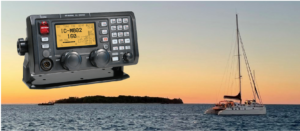

Online Marine Radio Exam Instructions
The following instructions will be emailed when you book your exam. They explain the rather complicated process of paying for and applying for your marine radio licence, joining the exam and undertaking the practical component. Please read these carefully.
- Complete the application form and email it off to the AMC with a digital passport-style photo for your radio license. The form is provided by the AMC on confirmation of your exam, and by us when you book your exam. You can also use the following links:
LROCP Application
SROCP Application
- Go to the AMC website to pay the $89 fee. Their payment page is https://payments.utas.edu.au/AMCPayments/menu
Select ‘OMC Exams and Certificates’
On the ‘Product’ drop down menu select ‘SROCP Exam’ or ‘LROCP Exam’ (even though you are actually paying for the licence not the exam!).
- Regardless of whether you complete the above, a few days before the exam the AMC will send you a link and instructions for their aXcelerate learning management system on which you do the exam. You need to follow these instructions to create an account ahead of the exam.
- At least 15 minutes before the exam log into aXcelerate and go to the assessments table on the left hand side halfway down the screen. If you get stuck, consult the instructions provided by the AMC. Please DO NOT click on Start Attempt until we are all ready to go.
- Once logged on to aXcelerate, join our Zoom Meeting. The purpose of Zoom is so that you can be ‘supervised’ during the exam and also do the practical assessment.
The Zoom link is: https://zoom.us/j/6359211645
(this link is subject to change. Use the link emailed to you if possible)
For the exam:
- Please join 15 minutes before the exam start time for an id check and briefing, having already logged on to aXcellerate.
- For the id check you need a drivers licence or passport (or other form of photo id) that you can show me.
- Ensure that you do not have any notes visible or accessible during the exam. For the Zoom session, you can use your computer or phone. If using your phone you will need to download the Zoom Meeting app ahead of time.
- The maximum time for written exam is 30 minutes (SROCP) or 60 minutes (LROCP). Most people take much less.
- Once you have finished the exam you will go to a breakout room for a practical test of a routine call, mayday call, and explain how to power up a unit, use the volume, squelch and channel selector, set a transceiver for dual watch and make a DSC distress call. You do not need any equipment for this. Prior to the exam I will run through this in detail, reminding you of what is expected.
- Please note a few items that often confuse people.
- Channel 13 is designated for use on a worldwide basis as a navigation safety communication channel, primarily for intership navigation safety communications. It may also be used for the ship movement and port operations service subject to the national regulations of the administrations concerned.
- An EPIRB battery must have an operational life when activated of 48 hours.
- 12 dots emanating from the centre of a radar screen show the position of a Search and Rescue Transponder (SART)
Good luck!
PLEASE NOTE: The Long Range (LROCP) includes the Short Range (SROCP). You do not need to do both. For obtaining an MMSI and for most people the VHF (Short Range) is all you need.
VHF (Short Range)
9 lessons of 30-40 mins each
Approx. 5 hrs total
- Parts and operation of a VHF radio
- How to call for help in an emergency
- Communicating with other vessels at sea
- Use of Digital Selective Calling (DSC)
- Other maritime distress and safety systems
- Maintenance and emergency repairs of power supply and radio equipment
MF/HF (Long Range)
10 lessons of 30-40 mins each
Approx. 6 hrs total
- Everything in the VHF course plus:
- Parts and operation of a MF/HF radio.
- MF/HF bands and frequecnies, including emergency and calling frequencies.
- MF/HF radio wave propogation and how to find the best frequency for the ionospheric conditions.
Take the first lesson for no cost to get a taste before you commit. Click ‘Enrol’ below to go to our courses site and register.
Frequently Asked Questions
Do you need a marine radio license to operate a VHF radio in Australia?
It’s just like driving a car – you can drive without a license, but its not legal, and not a great idea. Plus, doing the course and gaining the licence helps ensure you know the proper procedures in an emergency.
Do individual marine radios need to be licensed?
Marine VHF transceivers now operate under a class licence, there is no requirement for an official call sign and maritime ship station licence, but the operator must have as a minimum Short range certificate of proficiency (Marine radio operator’s VHF certificate of proficiency).
What is an MMSI and do I need one?
An MMSI – or Maritime Mobile Service Identity – is a unique 9-digit number that is programmed into your VHF and/or AIS. The number identifies you and your vessel to emergency services. It allows you to push a button on your transceiver (the DSC button) to make a distress call, conveying vital information to rescuers.
MMSIs are issue by AMSA (Australian Maritime Safety Authority). You must have a marine radio operator qualification in order to get an MMSI.
You are required to apply for an MMSI if you have the following equipment:
- fixed very high frequency (VHF) radio with digital selective calling (DSC)
- a handheld VHF DSC
- high frequency (HF) DSC
- automatic identification system (AIS)
Does the Marine License Expire?
No. The licence does not expire and does not need to be renewed.
How do you conduct practical test online?
There are five competencies that need to be demonstrated during the practical:
- Turning on a unit, changing channel, adjusting volume and squelch
- Make a DSC Distress call
- Making a MAYDAY call
- Logging on to VMR
- Set a channel for dual watch
During the practical we simulate the MAYDAY and log in, and candidates describe how they would undertake the other operations.
What is the range of a VHF transceiver?
The VHF band is line of site. It usually does not bend like lower frequencies do. Line of site varies, but is around 10-15 nautical miles.
Do we need marine radios when we have mobile phones?
In certain emergencies it may be best to use a mobile phone if it is in range. However, the advantage of a VHF unit is that it is a public broadcast, so other vessels may be able to assist more quickly than emergency services. If you are out of mobile range you may still have VHF range, especially via a repeater, and other vessels may be able to relay your message.
Should I get a GPS in my marine radio?
A GPS receiver for a VHF radio is highly recommended as it means a DSC alert will include your location.
What is the OMC?
The Office of Maritime Communications is the only body in Australia that can award marine radio qualifications. The office is part of the Australian Maritime College, Australia’s national institute for maritime training, education and research.
Does an MF/HF unit need to be licenced?
Yes, the apparatus needs to be licenced and the operator requires a Certificate of Proficiency. When the apparatus is licenced a call sign will be issued by the ACMA (Australian Communications and Media Authority). This is unlike a VHF unit which is covered by a class licence, and only the operator needs to be qualified.
How long does it take of a marine licence to be issued?
The Office of Maritime Communications has a maximum of 15 workings days upon receipt of your application and completion of the exam to finalise processing. Postage time is additional. So, allow 4 weeks.
